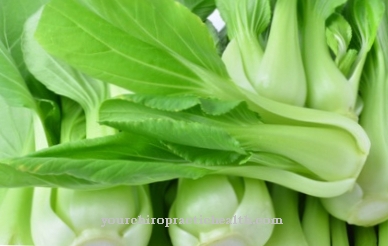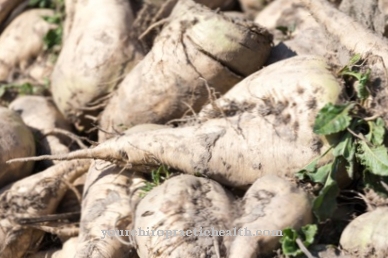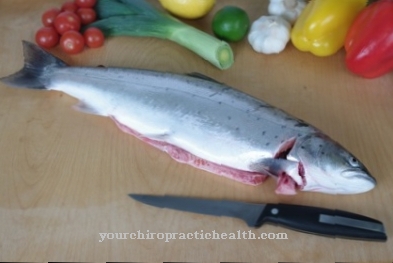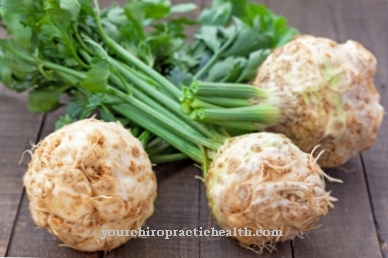Of the Chinese cabbage, which comes from East Asia and belongs to the cruciferous vegetables, has also been known in Germany for several decades. It can be bought in stores mainly in autumn and winter.
What you should know about Chinese cabbage

The name Chinese cabbage also reveals its country of origin. It was first grown in the Middle Kingdom in the fifth century. Ten centuries later, the cabbage came to Korea and Japan.
Even today these three countries are the main growing areas of the Chinese cabbage, which also Peking cabbage, Japanese cabbage or Celery cabbage is called. Cabbage is one of the most important sources of food in the main growing areas. It is believed that the vegetable was crossed from the turnip and mustard cabbage. In terms of external shape, the vegetable differs from other types of cabbage in that the stalk is missing. The firm outer leaves of the cabbage close together to form a conical or round-oval head. The advantage of Chinese cabbage is that, thanks to the mustard oils it contains, it is much easier to digest than other types of cabbage. It is also good for digestion.
The upper parts of the cabbage leaves taste finer, while the taste becomes stronger towards the stalk.
The head, which can weigh two kilograms, is yellow to golden yellow on the inside. The Chinese cabbage is sown in July and is available in September after eight to ten weeks. The harvest can take place until winter. This must be done carefully, as the leaves break quickly and injuries can lead to rotten spots. The Chinese cabbage can be stored in cold stores after harvesting, so that domestic cabbage can be bought until March. There will also be summer cultivation of Chinese cabbage from March, which will be available from May. The vegetables are also grown under glass so that they are available all year round.
Importance to health
The easily digestible Chinese cabbage is a good alternative for those who have problems with the other domestic cabbage varieties. It also has very few calories and is therefore also suitable for a figure-conscious diet.
Chinese cabbage contains many healthy nutrients such as B vitamins, vitamins C and K, calcium, potassium and folic acid. The B vitamins it contains are essential for the functioning of the nerves, skin, hair and blood, for example. The high-quality amino acids and mustard glycosides contained are also beneficial. The glucosinolates, the secondary plant substances, have a variety of health-promoting effects: They strengthen the immune system, lower the cholesterol level and protect the body's cells, for example. The Chinese cabbage has a stimulating and digestive effect.
The substance brassinin contained in Chinese cabbage can inhibit the growth of tumors. The Chinese cabbage is also recommended for pregnant women. The reason for this is folic acid. This vitamin is responsible for the healthy development of the embryo in the womb.
Ingredients & nutritional values
| Nutritional information | Amount per 100 gram |
| Calories 12 | Fat content 0.2 g |
| cholesterol 0 mg | sodium 11 mg |
| potassium 87 mg | carbohydrates 2.2 g |
| protein 1.1 g | Vitamin A 263 IU |
Chinese cabbage contains more than 90 percent water, but it is also rich in healthy nutrients. It is an excellent source of vitamin C, especially in winter. But calcium, potassium and folic acid are also abundant in it. Other important ingredients are the high-quality amino acids and mustard oil glycosides. The mustard oils contained make the vegetables easy to digest and provide the typical taste. Thanks to the few calories, the Chinese cabbage is an ideal slimming agent. There is almost no fat in healthy vegetables.
Intolerances & allergies
In general, Chinese cabbage is very healthy and easy to digest. However, some people suffer from uncomfortable flatulence after consumption. This is due to the fibers it contains, which the intestine cannot digest. They are not broken down, from which the intestinal gases result. There are hardly any gases when the Chinese cabbage is placed in the freezer for one or two days and only then used for cooking. The vegetables are also better tolerated by adding caraway or fennel. Chinese cabbage is rather unsuitable for babies and children due to its rather high nitrate content.
Shopping & kitchen tips
When buying, you should make sure that the leaves of the Chinese cabbage are fresh and crisp and that they do not have any dark spots. This can avoid unnecessary waste.
A fresh head of cabbage looks juicy green and feels firm. Freshly bought, it can be kept for at least seven days in the refrigerator's vegetable drawer. Shortly blanched, the Chinese cabbage can be kept in the freezer for more than three months. The tender leaf veins of Chinese cabbage can also be eaten. The cleaning and preparation of the cabbage is very simple: any dead outer leaves are removed, the Chinese cabbage is briefly washed in cold salt water and allowed to drain in a sieve. Then the vegetables are chopped up according to the recipe.
All parts of the head can be used to prepare the various dishes. Chopped Chinese cabbage takes around five to ten minutes to cook, sauté, fry or steam. If the cabbage leaves are filled, they simmer for about 30 to 45 minutes or steam for 25 to 40 minutes. With gentle steaming, more of the ingredients are retained.
Preparation tips
The healthy Chinese cabbage can be used in a variety of ways in both cold and warm cuisine. It tastes great raw as a salad and, in contrast to leaf salads, it has the advantage that the leaves remain crisp and fresh for many hours even when mixed with dressing.
The vegetables are ideal, for example, for raw vegetable salads with chopped apples, grated carrots, peppers and fresh herbs. Due to its fine texture, the cabbage can be cooked hearty but just as sweet. Sweet winter salads made from Chinese cabbage can be mixed with nuts and chopped organic orange peel, for example. If it is cut into strips and steamed briefly, the cabbage is a delicious accompaniment to briefly fried meat or fish. The Chinese cabbage should not be boiled in water, as it quickly loses its crunchy bite and becomes soft and bland. It is more ideal to steam the vegetables in oil for a short time. Soups, stews, stir-fries, casseroles and gratins can also be prepared well with the Chinese cabbage.
The Chinese cabbage should always be cooked last and only for a maximum of five minutes. Vegetables are an integral part of Asian cuisine, for example in delicious and healthy dishes from the wok together with chicken, paprika and broccoli. In addition, the delicate green leaves are ideal as a filling or cover. The Chinese cabbage is an optimal light food, because the tender leafy vegetables can be easily digested by the stomach. The specialty of Chinese cabbage is that it hardly smells and goes with almost everything, so there are hardly any limits to creativity.



























